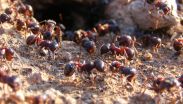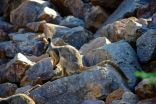Porter presented a talk titled "A Statistical Approach to Crime Linkage during a session focused on improving analysis of defense systems using statistical methods. He collaborated on the project with Brian J. Reich, associate professor of statistics at North Carolina State University.
Crime linkage is the investigative process of identifying a crime series--a group of crimes committed by the same person or group of people. The goal of the crime linkage model and resulting software is to help crime analysts more quickly and easily sift through massive amounts of crime data to accurately discover patterns that could indicate a crime series such as one of the most difficult crimes to solve: burglaries.
"Establishing that a set of crimes is attributable to a common offender or set of offenders is a critical first step to bringing an end to the crime spree and apprehending the criminal or criminals," said Porter, assistant professor of statistics at the University of Alabama, during his presentation.
Currently, police investigators must manually sift through hundreds of cases and use their expert judgment to determine whether a series of crimes is linked. Even while using query-enabled databases it is a complicated task, requiring the crime analyst to make complex comparisons of the similarity and distinctiveness of crime scene characteristics, the criminal's behaviors and any eyewitness descriptions.
The crime linkage model complements an analyst's experience and knowledge by enabling the investigator to pool information from various crime scenes, strengthening the case against a serial offender and aiding in profiling the criminal. "The model offers the potential to put linkage analysis on a more reliable and scientific basis, increases standardization, reduces the workload of police investigators and improves the prospect of using linkage analysis as evidence in legal proceedings," explained Porter.
It also can predict the likely location of the next event in an offender's crime series, an important aspect of tactical crime analysis. It does so by weighting more recent events stronger to capture changes in the criminal's behavior--namely site-selection and crime-scene behaviors.
In the course of planning and carrying out a crime and in response to the situations encountered, an offender will make a series of decisions--perhaps unknowingly--resulting in a unique set of behaviors, commonly known as modus operandi. Using statistical learning and data-mining algorithms, the model uses the measurable results of these decisions, recorded in a criminal incident database, to determine if crimes are linked.
Porter and Reich used 2001-2006 data on 10,670 burglaries in Baltimore County, Maryland, to build and test the efficiency of their crime-fighting model. The results show the model was highly effective in identifying crime series, including the following results:
The model captured 85% of links with only 5% false positives. The model has a precision of 91%, indicating 91% of the 100 highest-ranked pairs are true linkages. It identified 74% to 89% of true additional crimes from the series in a list of the top 50 crimes. When two or three crimes were already in the series, the model's performance improved to 86% to 91%. A typical breaking-and-entering crime series was committed within 8.3 square miles and a period of 266 days. Analysis of 590 crime series of four or more crimes indicates performance of next-event prediction varies greatly. If 10 square kilometers are monitored for the next breaking-and-entering crime in a series, the model can detect an average of 65% of the crimes.
Data from the Federal Bureau of Investigation estimates there were nearly 2.2 million burglaries in the country in 2010 and arrests were made in only 12.4% of the cases. The effectiveness of the model proves it is a promising crime-fighting tool that will be helpful to police investigators as they work to solve more burglaries, said Porter.
To encourage use of the model, Porter and Reich coded the model's algorithms in the R programming language and have made the software freely available to police departments, other law enforcement agencies and criminologists. "It is our hope the law enforcement and the crime research communities will use the model to combat and reduce serial crimes, such as burglaries," concluded Porter.
INFORMATION:
JSM 2015 is being held August 8-13 at the Washington State Convention Center in Seattle. More than 6,000 statisticians--representing academia, business and industry, as well as national, state and local governments--from numerous countries are attending North America's largest statistical science gathering.
About JSM 2015
JSM, which has been held annually since 1974, is being conducted jointly this year by the American Statistical Association (http://www.amstat.org), International Biometric Society (http://www.biometricsociety.org/) (ENAR [http://www.enar.org/] and WNAR [http://wnar.org/]) (http://www.biometricsociety.org/), Institute of Mathematical Statistics (http://imstat.org/en/index.html), Statistical Society of Canada (http://www.ssc.ca/en/whats-new), International Chinese Statistical Association (http://www.icsa.org/), International Indian Statistical Association (http://www.intindstat.org/), Korean International Statistical Society (http://www.statkiss.org/Home.php), International Society for Bayesian Analysis (http://bayesian.org/), Royal Statistical Society (https://www.rss.org.uk/), and International Statistical Institute (http://www.isi-web.org/). JSM activities include oral presentations, panel sessions, poster presentations, professional development courses, an exhibit hall, a career service, society and section business meetings, committee meetings, social activities and networking opportunities. Click here for more information about JSM 2015 (http://www.amstat.org/meetings/jsm/2015/index.cfm).
About the American Statistical Association
The ASA is the world's largest community of statisticians and the second-oldest continuously operating professional society in the United States. Its members serve in industry, government and academia in more than 90 countries, advancing research and promoting sound statistical practice to inform public policy and improve human welfare. For additional information, please visit the ASA website at http://www.amstat.org.



